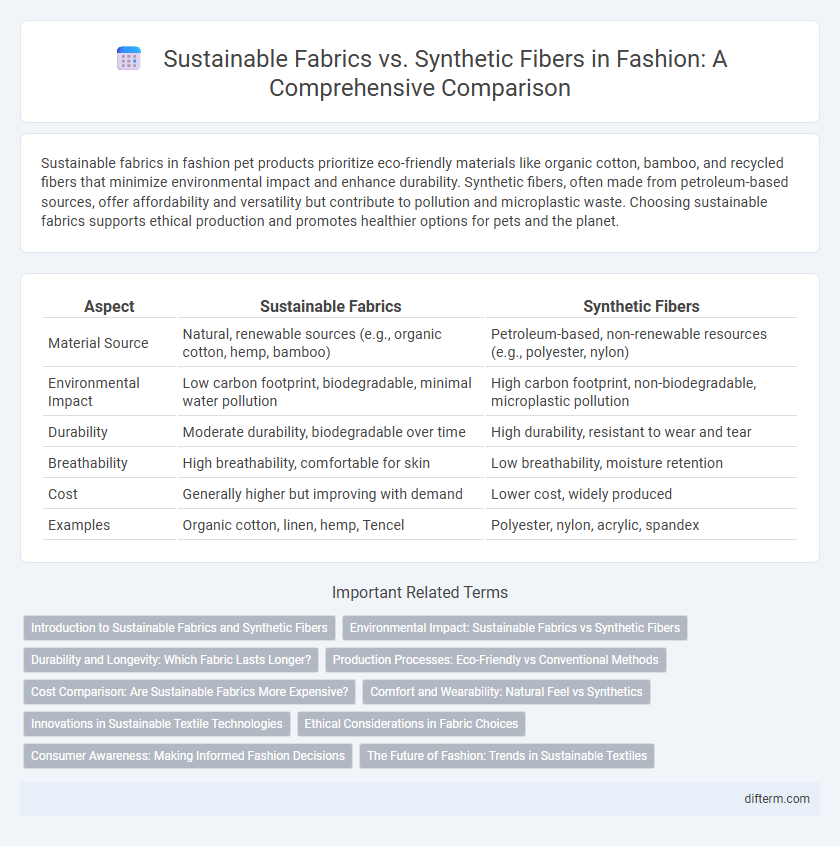Sustainable fabrics in fashion pet products prioritize eco-friendly materials like organic cotton, bamboo, and recycled fibers that minimize environmental impact and enhance durability. Synthetic fibers, often made from petroleum-based sources, offer affordability and versatility but contribute to pollution and microplastic waste. Choosing sustainable fabrics supports ethical production and promotes healthier options for pets and the planet.
Table of Comparison
| Aspect | Sustainable Fabrics | Synthetic Fibers |
|---|---|---|
| Material Source | Natural, renewable sources (e.g., organic cotton, hemp, bamboo) | Petroleum-based, non-renewable resources (e.g., polyester, nylon) |
| Environmental Impact | Low carbon footprint, biodegradable, minimal water pollution | High carbon footprint, non-biodegradable, microplastic pollution |
| Durability | Moderate durability, biodegradable over time | High durability, resistant to wear and tear |
| Breathability | High breathability, comfortable for skin | Low breathability, moisture retention |
| Cost | Generally higher but improving with demand | Lower cost, widely produced |
| Examples | Organic cotton, linen, hemp, Tencel | Polyester, nylon, acrylic, spandex |
Introduction to Sustainable Fabrics and Synthetic Fibers
Sustainable fabrics such as organic cotton, hemp, and bamboo are made from natural resources that minimize environmental impact through reduced water usage, lower carbon emissions, and biodegradability. Synthetic fibers like polyester, nylon, and acrylic are petroleum-based materials prized for durability and affordability but contribute significantly to microplastic pollution and fossil fuel depletion. The fashion industry increasingly contrasts these materials to drive eco-friendly innovation and responsible consumer choices.
Environmental Impact: Sustainable Fabrics vs Synthetic Fibers
Sustainable fabrics such as organic cotton, hemp, and bamboo significantly reduce environmental impact by minimizing water usage, lowering carbon emissions, and avoiding toxic pesticides. Synthetic fibers like polyester and nylon contribute to pollution through microplastic shedding and rely heavily on non-renewable fossil fuels. Choosing sustainable fabrics supports biodiversity conservation and reduces landfill waste compared to the persistent environmental footprint of synthetic fibers.
Durability and Longevity: Which Fabric Lasts Longer?
Sustainable fabrics such as organic cotton, hemp, and linen demonstrate exceptional durability due to their natural fiber strength and breathability, often improving with age and repeated washing. Synthetic fibers like polyester and nylon are engineered for high tensile strength and resistance to abrasion, offering prolonged longevity but can degrade through microplastic shedding over time. Evaluating durability involves considering the environmental impact alongside lifespan, where sustainable textiles provide a longer-term eco-friendly option with adequate wear resilience.
Production Processes: Eco-Friendly vs Conventional Methods
Sustainable fabrics, like organic cotton and hemp, use eco-friendly production processes that minimize water consumption, avoid harmful chemicals, and promote soil health through regenerative farming practices. In contrast, synthetic fibers such as polyester and nylon rely on energy-intensive, petrochemical-based manufacturing that generates significant greenhouse gas emissions and microplastic pollution. Choosing sustainable fabrics supports lower environmental impact production and advances circular fashion principles.
Cost Comparison: Are Sustainable Fabrics More Expensive?
Sustainable fabrics such as organic cotton, hemp, and Tencel typically have higher production costs due to eco-friendly farming practices and limited supply chains, making them more expensive than synthetic fibers like polyester and nylon. Synthetic fibers benefit from mass production and lower raw material costs, driving down prices for manufacturers and consumers. However, the long-term environmental and health costs associated with synthetic fibers often outweigh the initial savings, prompting a growing investment in sustainable alternatives despite their higher price point.
Comfort and Wearability: Natural Feel vs Synthetics
Sustainable fabrics such as organic cotton, linen, and hemp offer superior comfort through their breathability and moisture-wicking properties, creating a natural feel against the skin that reduces irritation. Synthetic fibers like polyester and nylon often trap heat and moisture, which can lead to discomfort during extended wear despite their durability and wrinkle resistance. Choosing sustainable fabrics enhances wearability by promoting airflow and softness, making clothing more comfortable for everyday use.
Innovations in Sustainable Textile Technologies
Innovations in sustainable textile technologies are revolutionizing the fashion industry by developing biodegradable fibers from renewable sources such as bamboo, hemp, and organic cotton, reducing reliance on oil-based synthetic fibers like polyester and nylon. Advanced processes like bio-based polymer synthesis and microbial cellulose production enhance fabric sustainability while maintaining durability and comfort. Emerging techniques such as waterless dyeing and closed-loop recycling systems further minimize environmental impact, promoting a circular fashion economy.
Ethical Considerations in Fabric Choices
Sustainable fabrics such as organic cotton, hemp, and Tencel significantly reduce environmental impact by utilizing renewable resources and biodegradable materials. Synthetic fibers like polyester and nylon, derived from fossil fuels, raise ethical concerns due to their non-renewable origins and microplastic pollution affecting marine ecosystems. Choosing sustainable fabrics supports ethical fashion practices by promoting fair labor conditions, reducing chemical use, and encouraging circular economy principles in textile production.
Consumer Awareness: Making Informed Fashion Decisions
Sustainable fabrics like organic cotton, hemp, and Tencel offer eco-friendly alternatives to synthetic fibers such as polyester and nylon, which are derived from petrochemicals and contribute to microplastic pollution. Increased consumer awareness drives the demand for transparency in the fashion industry, encouraging brands to disclose fabric origins and environmental impacts. Understanding the lifecycle and ecological footprint of textiles empowers consumers to make informed fashion decisions that prioritize sustainability and ethics.
The Future of Fashion: Trends in Sustainable Textiles
Sustainable fabrics such as organic cotton, hemp, and Tencel minimize environmental impact through biodegradability and reduced water consumption compared to synthetic fibers like polyester and nylon, which rely on fossil fuels and contribute to microplastic pollution. Innovations in recycled materials and bio-based fibers are driving the future of fashion by combining durability with eco-friendly production methods. Market demand for transparency and ethical sourcing is accelerating the adoption of sustainable textiles in global apparel supply chains.
Sustainable fabrics vs synthetic fibers Infographic

 difterm.com
difterm.com